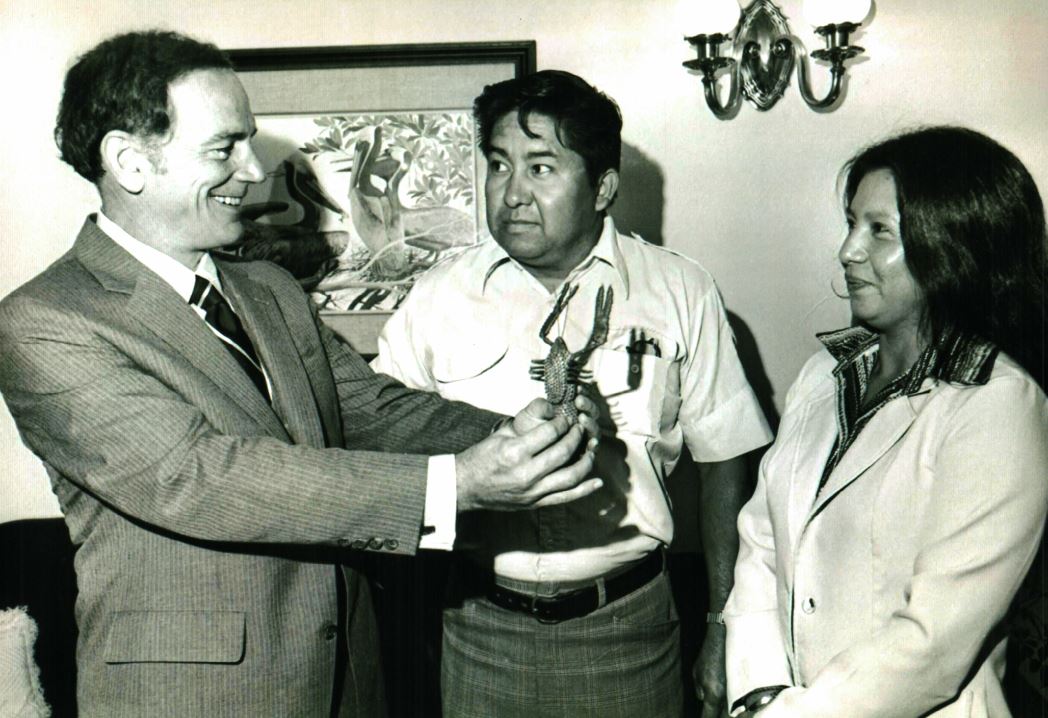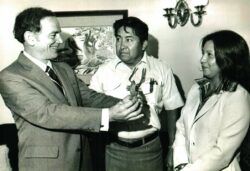Native American Civil Rights Movement in Louisiana
Following World War II, many Indigenous Louisianans joined regional and national efforts to promote tribal sovereignty, economic justice, and educational equality.

Private Collection of Ernest Sickey
From left to right: Senator J. Bennett Johnston, Coushatta tribal chairman Ernest Sickey, and tribal secretary Barbara Langley, ca. 1970.
In the 1970s and 1980s, Louisiana Indigenous leaders and activists joined efforts to address the political, social, and economic outlook of the state’s Native population. Leveraging the momentum of Black civil rights activities, a region-wide movement emerged among Indigenous peoples who shared similar complaints and experiences about the social injustices of racial segregation, discrimination, and violence. This movement brought disparate interests together to assert a pronounced Indigenous identity. While there were overlapping concerns regarding civil rights violations on a national scale, Indigenous leaders and activists advocated for the individual rights of Native people as well as the cultural and political integrity of Indigenous groups or communities looking to develop resources, acquire land, and access education, employment, and healthcare opportunities. They used the language of self-determination, emphasizing their unique, extraconstitutional relationships with the United States as preexisting sovereign nations.
The diversity of Louisiana’s Indigenous populations—identified by locale, historical experiences, ancestral backgrounds, language, degree of political organization, and cultural maintenance—dictated different groups’ roles within the state-wide movement. This diversity played out against the backdrop of national shifts in how American Indian identity was formed, articulated, and scrutinized as part of a highly politicized federal recognition policy. With a dramatic increase in people identifying as American Indian on the US census in Louisiana—from 3,578 in 1960 to 12,065 in 1980—Indigenous people’s amplified visibility and mobilization in the state reflected similar trends across the southeast. Activists and leaders from across Louisiana, whether from one of the Choctaw, Tunica-Biloxi, Houma, Chitimacha, or Coushatta communities, spent the better part of the last decades of the twentieth century working to build inter-tribal coalitions. While these efforts varied in goals and success levels, they defined a formal relationship between tribes and the state government and, for some, a political and legal relationship with the federal government.
Context
Following World War II, the Indigenous peoples of Louisiana faced the challenges of racial polarization within a Jim Crow system where many experienced barriers due to segregation in schools and public spaces, employment discrimination, and were denied the ability to own land. This polarization was compounded by the impact of the federal government’s attempts to enact a series of programs and policies to terminate its responsibility to tribes. Louisiana was among the initial list of states under consideration for eliminating the scarce federal funding previously provided to a few tribes for schools and healthcare, resulting in the Coushatta Tribe of Allen Parish being cut off from such services in 1953. The Chitimacha Tribe of St. Mary Parish (recognized in the early twentieth century) then became the only tribe to continue receiving federal funding in the state. While there were earlier efforts toward inter-tribal organizing in the 1920s and 1930s, the anxiety that the post-war policies and practices generated, coupled with the severe poverty and lack of opportunities, encouraged many Indigenous Louisianans to join national efforts to reverse the course of federal policy and promote tribal sovereignty, economic justice, and educational equality. In 1961, for example, members from both Houma and Choctaw communities traveled to the University of Chicago to attend the American Indian Chicago Conference alongside five hundred other participants representing tribal nations across the United States. One of the outcomes of this gathering was the “Declaration of Indian Purpose,” which emphasized Native self-determination and was delivered to President John F. Kennedy. The declaration laid the foundation for Congress to reexamine its obligation to tribes and eventually pass the Indian Self-Determination and Education Assistance Act in 1975. Throughout the 1960s and 1970s, Native leaders and activists across the state also sought to broaden their networks and access to information by joining or seeking assistance from the National Congress of American Indians, the Native American Rights Fund, the National Council on Indian Opportunity, the Association on American Indian Affairs, the Coalition of Eastern Native Americans, the Indian Information Project, and the United Southern and Eastern Tribes, Inc.
The political activities of national groups like the American Indian Movement (AIM) and United Indians of All Tribes influenced events in Louisiana when Baton Rouge-based Indian Angels, Inc. (founded in 1969) adopted similar rhetoric and practices. Inspired by the occupation of Alcatraz Island (1969), the stand-off at Wounded Knee (1973), and the Longest Walk (1978), the Indian Angels likewise used the media as a platform to direct the attention of Louisiana politicians and the public to the need for additional social services for the state’s Native populations. Members of this organization staged marches to the governor’s mansion, where they were featured in newspapers wearing feathers, face paint, and beads, carrying American flags, and chanting in the streets.
While the Indian Angels increased the public visibility of Louisiana’s Indigenous population, others leveraged their local political connections to secure support and opportunities. For example, Coushatta leader Ernest Sickey began working with Judge Minos D. Miller and attorney Ruth Loyd Miller, whose political connections got Sickey an audience with some of the state’s most politically influential and economically elite individuals. This access, paired with the 1971 election of Democratic Governor Edwin Edwards, fostered a unique opportunity for the emergence of a formal inter-tribal agency to be established within the state government.
Louisiana Tribes Formally Organize
On May 30, 1972, Governor Edwards signed the executive order to create the Louisiana Office of Indian Affairs (LOIA). While more states, particularly in the southeast, also created state agencies in the 1970s to secure federal funding and work to influence social change for Native groups, this was a relatively new phenomenon given the historically contentious relationship between tribes and states. Upon creating the LOIA Edwards appointed David L. Garrison, an attorney located in Lake Charles and heir to the Bel Oil Company, as its first commissioner. Subsequently, Ernest Sickey was named the deputy commissioner and later succeeded Garrison as commissioner, making him the first Indigenous Louisianan to work in coordinating Native affairs. Sickey saw inter-tribal cooperation as the key to addressing the needs of Indigenous peoples in Louisiana through what he described as “sound management concepts while still maintaining an Indian identity.”
At its inception the LOIA was defined as a technical assistance office. In its early years it served the Chitimacha Tribe, Coushatta Tribe, Jena Band of Choctaws, Tunica-Biloxi Tribe, United Houma Nation, Clifton Choctaw Tribe, Choctaw-Apache Community of Ebarb, and the Louisiana Band of Choctaw. Assistance was conceived to include aid in conducting tribal community needs assessments, securing funding, and creating a mechanism by which Louisiana formally recognizes tribes, simultaneously advocating for the federal government to do the same. Applying a state recognition criterion was highly controversial, further complicating legal definitions of “Indianness” as southern states followed a similar trajectory in developing their criteria just as the federal criteria were formalized in 1978 with the Office of Acknowledgment within the Department of Interior. This was a hopeful time for the dozens of southern Indigenous groups scattered throughout the region with no formal political status. Petitions poured in, and by 1987 one-third of the total petitions for federal recognition had come from groups in the southeast, a region where Indigenous peoples endured warfare, diaspora, removal, and attempted erasure leaving remaining communities much more likely to need “recognition” than in the west. Ultimately tribal recognition—whether at state or federal levels—became a politically charged issue, with many finding it problematic and highly subjective.
The Coushatta Tribe served as the Louisiana test case when in 1972, close to the inception of the LOIA, the state passed a resolution giving the Coushatta Tribe state recognition and calling on the federal government to do the same. Through an unprecedented series of events, just fourteen months later, after much lobbying and support from Louisiana legislators, the tribe was administratively recognized by the federal government, and a Coushatta reservation was established. The following year the Jena Band of Choctaws of LaSalle Parish organized a tribal governing body and, with state recognition, also used the technical support from the LOIA to acquire land and obtain resources. The Jena Choctaws became federally recognized in 1995. The LOIA also provided other tribes with the technical support they needed to launch economic enterprises. For example, the Chitimachas used assistance to construct a craft workshop, and the Houma developed a shrimp co-op.
While the LOIA was a starting point for advancing inter-tribal interests, even serving as a concrete symbol of the changing times, it was not as effective as many had hoped. A lean budget coupled with bureaucratic barriers, concerns about the credibility of the state recognition process, and the geographic distance between tribal communities that impeded communication stalled efforts through the 1970s, leaving some tribal leaders looking for alternative ways to organize. In 1974 the nonprofit Inter-Tribal Council (ITC) of Louisiana was incorporated. Unlike the LOIA, the ITC only served five tribes—the Chitimacha, the Jena Band of Choctaw, the United Houma Nation, the Tunica-Biloxi, and the Coushatta—who coordinated their efforts to apply for shared grants aimed at improving education, mental health, public relations, and the economic outlook of the member tribes. One of the initial grants administered by the ITC was received as part of an annual grant from the Comprehensive Employment and Training Act. While ITC tribes continued to also participate in the LOIA, the relationships between the two organizations became strained.
Continued Efforts to Unify
Louisiana Native affairs transitioned in 1980 with the election of Republican Governor David Treen and a national economic shift toward using federal block grants distributed to state and local governments. Within an increasingly economically conservative environment, Indigenous leaders and activists moved away from the approach of positioning Native people as an overlooked minority and, more prominently, focused their messages on economic independence. This strategy proved effective, as state officials supported programs that promised to be self-sustaining, thus minimizing the concern that Indigenous peoples would become a welfare burden to the state. As a result the LOIA received its first substantial monetary commitment, the Louisiana Indian Housing Authority was created, and the LOIA board was reorganized to comprise the elected leaders from each of the state-recognized tribes. Helen Gindrat (Houma) was appointed as executive director and set out to reinvigorate earlier enthusiasm around creating a cohesive political identity for the state’s Indigenous population by bridging the gap between the LOIA and ITC and encouraging tribal leaders to improve lines of communication. In 1981 the Tunica-Biloxi Tribe joined the Chitimacha and Coushatta Tribes when it became federally recognized, contributing to a renewed willingness of tribal leaders to find ways to work together. That same year, tribal representatives from across the state convened in Jena for a historic meeting, culminating in a formal “Declaration of Unity” that was a precursor to a position paper from the “Undersigned Sovereign American Indian Tribal Governments of Louisiana” that was distributed to state legislators. The document outlined the history of tribal-state relationships and defined Native tribes as distinguishable from other “ethnic groups” because they “are units of government and should be treated as such by the state government of Louisiana.” The document set the tone for building tribal unity across the state, one that was also championed by Gindrat’s successor, Clyde Jackson (Jena Band of Choctaws), who became the executive director of the LOIA in 1983.
The 1980s offered Louisiana tribes an opportunity to define their identities as Indigenous nations. The influence of the national movement toward self-determination, as well as a regional trend toward state governments becoming more receptive to developing relationships with tribal groups, gave Indigenous leaders an unprecedented opportunity to draw attention to the problems of continued discrimination and poor living conditions—one that continued to evolve over the following decades.
